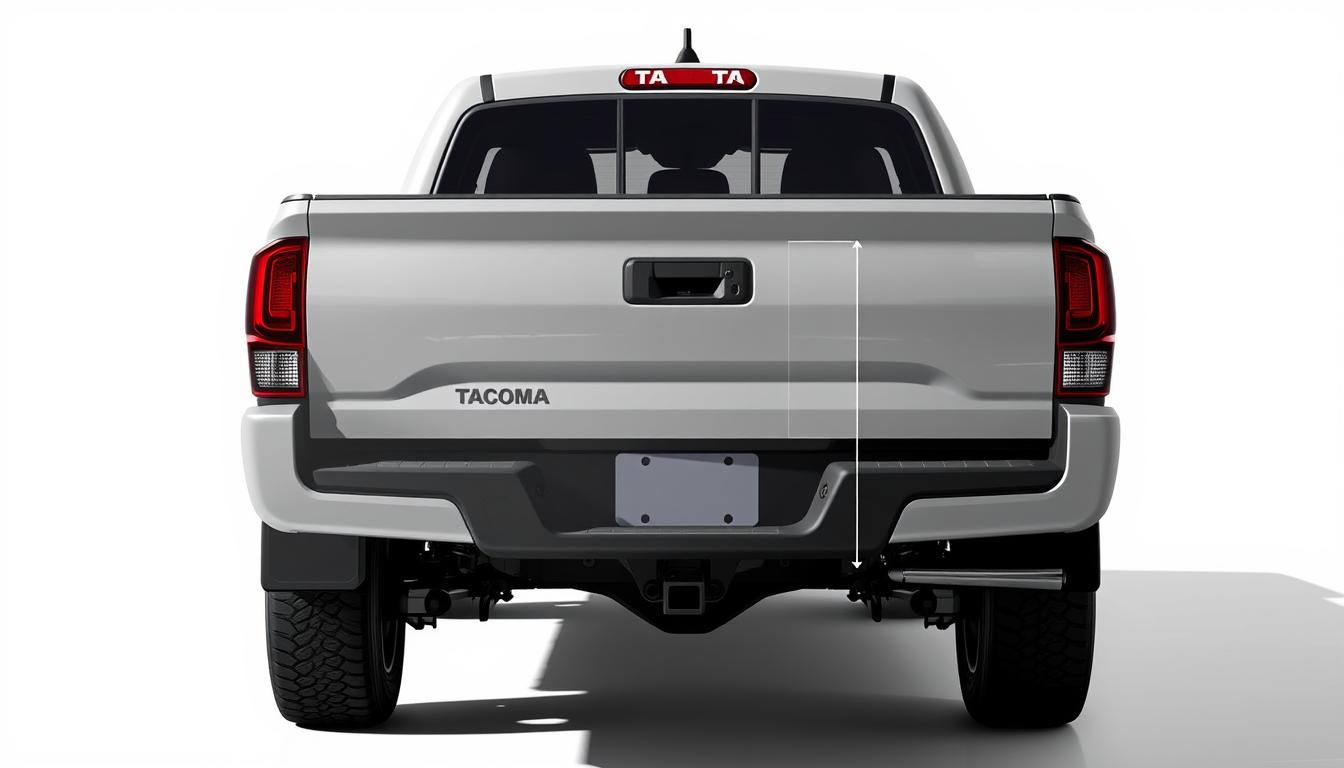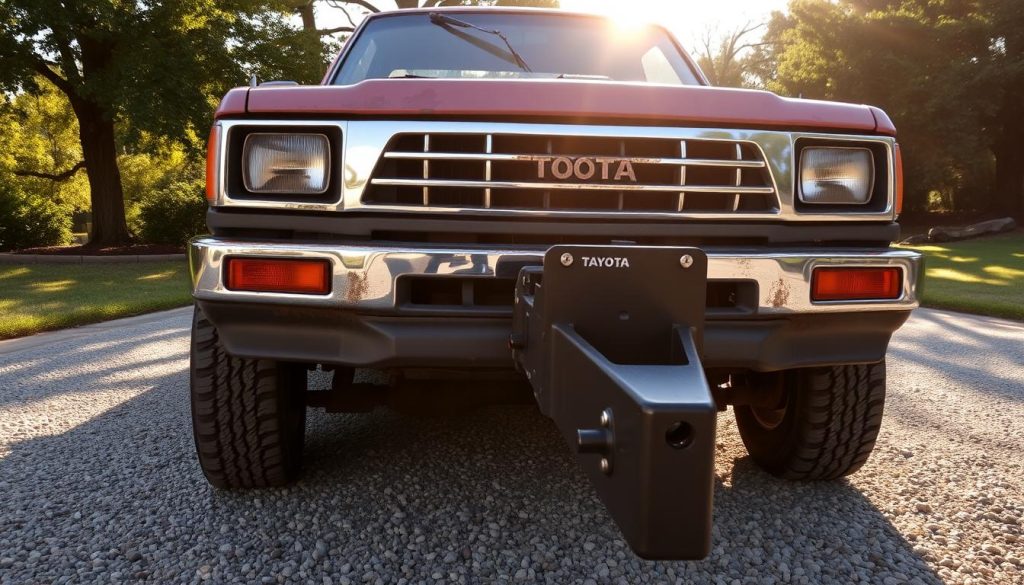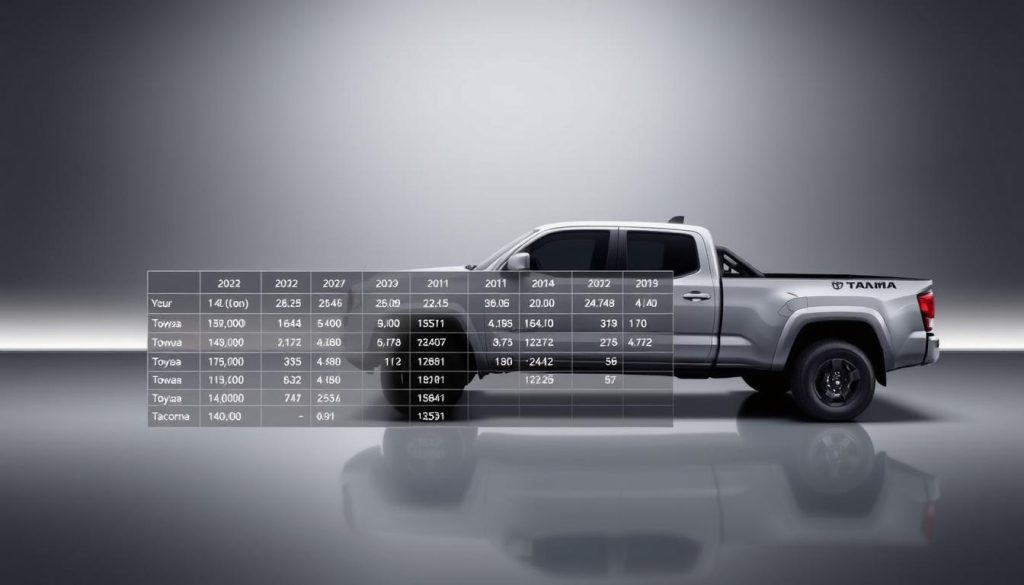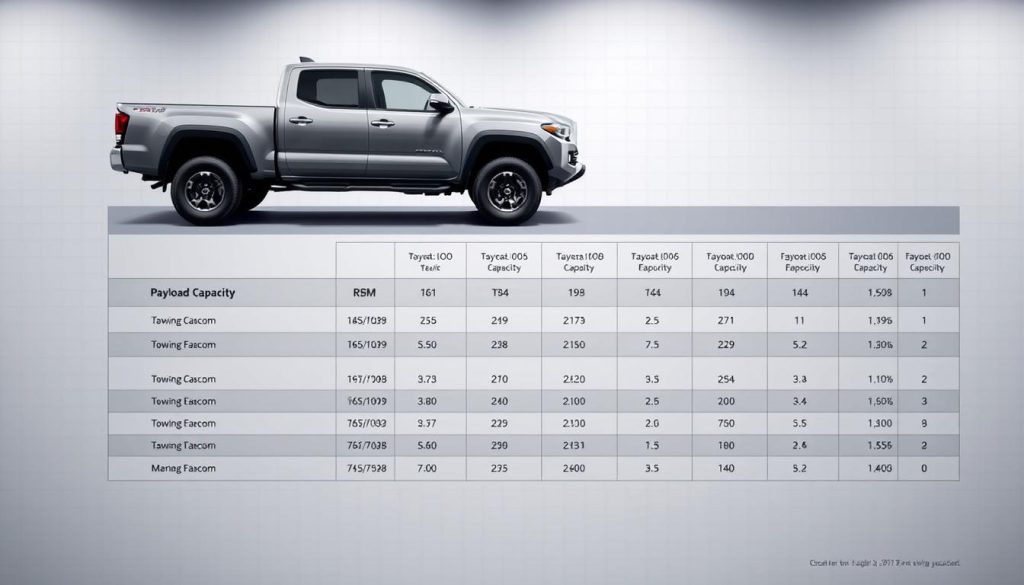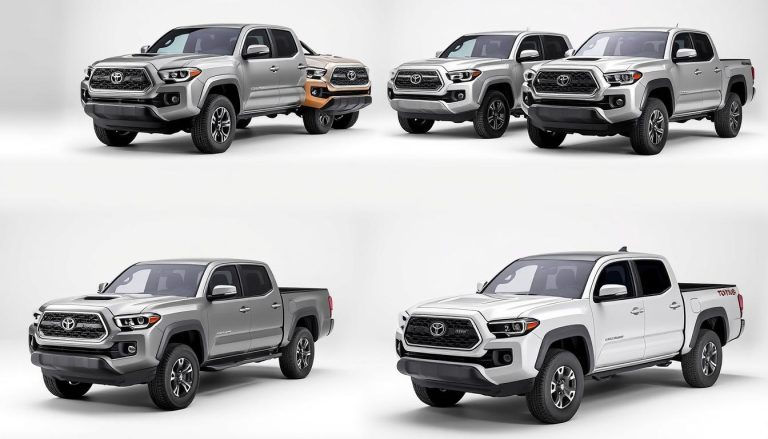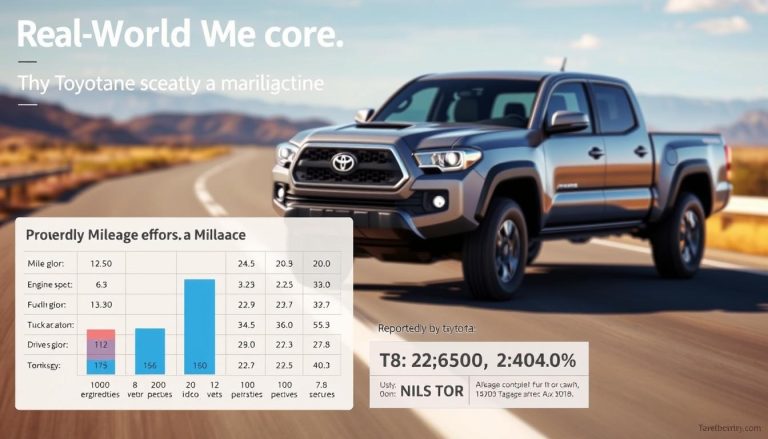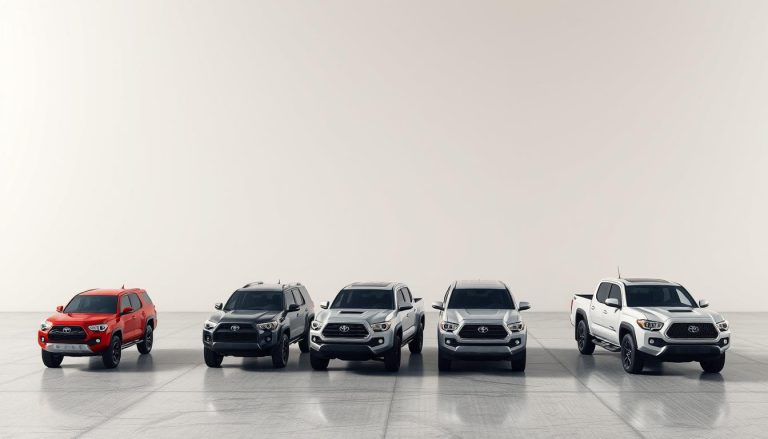Tacoma Towing Capacity by Year: Ultimate Guide
The Toyota pickup truck has changed a lot over nearly three decades. It started in 1995 and now is a powerful hauling machine. It impresses drivers all over America.
The 2025 models can haul up to an amazing 6,500 pounds. They come with two engines. The first is a 2.4-liter turbo four-cylinder with 278 horsepower and 317 lb-ft of torque. The second is a 2.4-liter turbo hybrid with 326 horsepower and 465 lb-ft of torque.
This guide helps you understand tacoma towing capacity by year for all models. It’s useful whether you’re looking for a used truck or want to get the most out of your current one. Knowing how the towing specs have changed helps you make smart choices.
Each new generation of Tacoma has made big improvements. These include better hauling, safety, and driving experience. The changes show Toyota’s dedication to making great trucks.
Key Takeaways
- Modern models can haul up to 6,500 pounds with proper equipment
- Two engine options available: standard turbo and hybrid turbo systems
- Three generations show steady improvement in hauling capabilities
- Engine specifications directly impact maximum hauling performance
- Understanding model differences helps choose the right truck for your needs
Understanding Toyota Tacoma Towing Specifications
Before we dive into specific model years, let’s understand towing capacity. Towing capacity is the maximum weight your Toyota pickup can legally and safely tow. It ensures you can control your truck while driving.
This rating is more than just pulling power. Toyota engineers design these specs to keep your truck safe. They make sure your truck can stop and turn well, even with a trailer.
Many factors affect your Tacoma’s hauling ability. Knowing these helps explain why different models have different towing ratings:
- Engine power – More power means you can tow more
- Axle ratio – Lower ratios help with towing
- Cab and bed style – Different styles change how weight is spread
- Drive type – Two-wheel drive or four-wheel drive matters
- Transmission type – Manual or automatic affects towing
Toyota’s team tests these ratings carefully. They check the transmission, cooling, suspension, and weight distribution. This ensures your Tacoma can handle a trailer safely.
The payload capacity of the Tacoma changes with each model year. Knowing these basics helps you see why some models can tow more. It’s important to stay within these limits for safety and to keep your truck in good shape.
Respecting these limits is key for safety and keeping your truck running well. Toyota’s specs are not just guesses. They are the maximum safe weight for your truck.
First Generation Tacoma Towing Performance (1995-2004)
From 1995 to 2004, the first Tacoma was known for being reliable and good at towing. It was designed to handle daily tasks and weekend fun. The early Tacomas showed that reliable engineering means consistent performance.
Over the years, Toyota made the Tacoma better at towing. It started small but grew into a more powerful truck. These changes were based on what customers wanted and Toyota’s drive to improve.
1995-1997 Tacoma Towing Specifications
The first Tacomas had tacoma tow ratings that focused on being reliable. The 2.4-liter engine was enough for small trailers and toys. It had enough power for light-duty towing.
The 2.7-liter engine offered better towing. Both engines came with manual transmissions. The automatic option was smoother but had less capacity.
Most 1995-1997 Tacomas could tow 3,500 to 4,000 pounds with the right setup. This was good for the small trucks of the 1990s.
1998-2000 Model Updates and Capacity Changes
Toyota added the 3.4-liter V6 engine in 1998. This made towing much better. The V6 engine was the top choice for those who needed to tow more.
The tacoma maximum trailer weight went up to about 5,000 pounds with the V6. This was great for boat and RV owners. The truck’s cooling and transmission were also improved.
Toyota also made the suspension better for towing. This made the truck more stable and confident on the road.
2001-2004 Late First Generation Improvements
The last years of the first Tacoma were the best. Toyota had made many improvements based on customer feedback. The 2001-2004 models could tow the most of any first-generation Tacoma.
With the right setup, these Tacomas could tow up to 6,000 pounds. This was a big jump from the early models. The improvements were in engine, transmission, and cooling.
The late first-generation Tacomas set the stage for future trucks. They were reliable and capable, meeting many needs. These trucks showed that you didn’t need a lot of towing power to be useful.
| Model Years | Engine Options | Maximum Towing Capacity | Key Features |
|---|---|---|---|
| 1995-1997 | 2.4L 2RZ-FE, 2.7L 3RZ-FE | 3,500-4,000 lbs | Manual transmission standard |
| 1998-2000 | 2.7L 3RZ-FE, 3.4L 5VZ-FE V6 | 3,500-5,000 lbs | V6 engine introduction |
| 2001-2004 | 2.7L 3RZ-FE, 3.4L 5VZ-FE V6 | 3,500-6,000 lbs | Enhanced cooling systems |
Second Generation Tacoma Towing Capabilities (2005-2015)
The 2005-2015 Tacoma marked a big change in Toyota’s towing capacity. They simplified the confusing specs from before. Now, there were just two clear options for truck buyers.
The basic setup could tow 3,500 pounds without extra gear. But, for more hauling, the toyota tacoma tow package was available. It boosted capacity to 6,500 pounds.
This generation was a big step up in design and power. It had a better ride and more advanced towing systems. Toyota aimed to make it more refined while keeping its ruggedness.
2005-2009 Early Second Generation Models
The early models had a new design and better structure. They looked modern and were stronger. The 4.0-liter V6 engine was key for serious towing.
Toyota improved the transmission cooling. This was important for keeping the truck cool during long hauls. Manual transmissions were less popular for serious towing.
The electrical systems also got better. New alternators and wiring supported trailer lights and brake controllers. This made the Tacoma reliable for heavy loads over long distances.
2010-2012 Mid-Cycle Enhancements
The mid-cycle update improved towing performance. Toyota made the engine better for pulling trailers up steep hills. This made towing more comfortable.
Suspension parts were also updated. New rear springs and shock absorbers carried more weight. This helped keep the truck stable near its towing limits.
Inside, the gauges got better for towing info. Drivers could see transmission temperature and more. This helped them keep an eye on the truck’s condition during tough towing.
2013-2015 Late Second Generation Updates
The late years of the second generation were perfecting towing. The 2013 models had better engine calibrations for fuel economy. This made the truck efficient for driving and towing.
The toyota tacoma tow package was at its best in these years. It included a heavy-duty radiator and more. A Class IV receiver hitch was standard with the package.
The 2015 model year ended this successful generation. By then, the Tacoma was a top contender in towing. Its 6,500-pound capacity with the tow package was competitive with bigger trucks.
| Model Years | Base Towing Capacity | With Tow Package | Required Engine |
|---|---|---|---|
| 2005-2009 | 3,500 lbs | 6,500 lbs | 4.0L V6 |
| 2010-2012 | 3,500 lbs | 6,500 lbs | 4.0L V6 |
| 2013-2015 | 3,500 lbs | 6,500 lbs | 4.0L V6 |
Throughout this generation, Toyota kept things consistent. The clear towing specs made it easy for customers to know what their truck could do. This approach helped avoid the confusion of earlier models and set clear expectations for buyers.
Third Generation Tacoma Towing Capacity (2016-2024)
The latest Toyota Tacoma trucks have the strongest towing power and daily use. This generation shows Toyota’s focus on advanced engineering and better performance. It shows how tacoma towing capacity by year has grown to meet today’s needs.
Toyota revamped the Tacoma for 2016, adding new looks and better features. The new design improved ride quality and comfort inside. Engineers worked hard to boost towing power while keeping fuel efficiency high.
The third generation models are very versatile. Base models can tow 1,000 pounds for light tasks. The top models can tow up to 6,800 pounds, great for heavy trailers and equipment.
“We engineered the third-generation Tacoma to deliver best-in-class capability without compromising the reliability our customers expect from Toyota.”
2016-2019 Early Third Generation Specifications
The early third generation Tacoma brought big changes. The 2016 model year started a new era for the Tacoma. Engineers aimed to make a truck that works hard but is also comfortable for daily use.
These early models had two main engine choices. The four-cylinder engine was good for lighter loads. The V6 engine could tow up to 6,800 pounds when equipped right.
Toyota also made the truck’s frame stronger during this time. The new design spread towing loads better. This helped keep the truck stable when pulling heavy trailers.
2020-2024 Current Generation Performance
Today’s Tacomas keep the 6,800-pound maximum towing capacity from before. But Toyota has made towing even better. Modern Tacomas have better transmission and cooling systems.
The payload capacity has also gone up. It ranges from 1,620 to 1,685 pounds depending on the setup. This makes current Tacomas great for work and towing.
The 2024-2025 models introduce the i-FORCE MAX hybrid system. This system can tow up to 6,500 pounds and saves fuel. It shows Toyota’s goal to mix power with eco-friendliness.
Now, all Tacomas come with advanced safety features. The Toyota Safety Sense 2.0 system includes trailer sway control and better stability management. These features make towing safer for everyone.
Looking at tacoma towing capacities over time shows the third generation is the best. Modern Tacomas offer the best mix of power, comfort, and reliability in the Tacoma’s history.
Complete Tacoma Towing Capacity by Year Breakdown
Looking at the toyota tacoma towing specs over nearly three decades is fascinating. Toyota has made the truck better at hauling over time. They’ve made changes based on what people want and new technology.
The story of the Tacoma’s towing power is one of steady growth. It started with basic towing and now it’s impressive. Each new generation has brought big improvements.
Year-by-Year Towing Specifications Chart
Here’s a detailed look at the Tacoma’s towing specs for each year. These numbers show the maximum tacoma hauling capability when everything is just right.
| Model Years | Maximum Towing Capacity | Generation | Key Features |
|---|---|---|---|
| 2024-2025 | 6,500 lbs | Third Generation | Refined V6 engine, updated transmission |
| 2020-2023 | 6,800 lbs | Third Generation | Peak performance years, enhanced cooling |
| 2016-2019 | 6,500 lbs | Third Generation | New platform, improved frame strength |
| 2005-2015 | 6,500 lbs | Second Generation | Major capacity increase, V6 standard |
| 2000-2004 | 5,000 lbs | First Generation | Basic towing package, four-cylinder base |
The toyota tacoma towing specs show a clear increase over the years. The biggest jump was from the first to the second generation, from 5,000 to 6,500 pounds.
Notable Changes Across Model Years
There have been many important changes in the Tacoma’s towing history. The biggest change was in 2005, when the second generation came out.
The 2020-2023 models were the best for towing. Toyota reached 6,800 pounds of towing capacity with better cooling and transmissions.
In 2024-2025, Toyota reduced the towing capacity to 6,500 pounds. This change focuses on reliability and better fuel use. It keeps the truck great for towing while making it last longer.
Knowing these changes helps buyers find the best Tacoma for their needs. Even older Tacomas are now good for most towing jobs thanks to these improvements.
Engine Options and Towing Performance Impact
Your Tacoma’s engine is key to how much you can tow. It’s not just about horsepower. Torque output, engine design, and power delivery all matter for towing.
Toyota has offered many engines for the Tacoma over the years. Each engine has its own strengths. Knowing these differences helps you pick the right truck for your needs.
Today’s Tacomas have advanced engines that are powerful yet efficient. They come in both traditional and hybrid types. These engines are better than older ones in power and smoothness.
Four-Cylinder Engine Towing Limits
Four-cylinder Tacomas have changed a lot. The old 2.7-liter engine could tow about 3,500 pounds with the right setup.
The new i-FORCE 2.4-liter turbocharged engine is a big step up. It makes 278 horsepower and 317 lb-ft of torque. The turbo gives better low-end torque than older engines.
The towing capacity of four-cylinder Tacomas varies. Most can tow between 3,500 and 5,000 pounds. The exact amount depends on the cab style, drivetrain, and options.
Four-cylinder engines are good for certain towing jobs:
- Small utility trailers under 3,000 pounds
- Lightweight camping trailers and pop-ups
- Personal watercraft and small boats
- Motorcycle trailers and equipment haulers
Four-cylinder engines also save on fuel. They get better gas mileage when driving and towing. This helps make up for their lower towing capacity.
V6 Engine Towing Advantages
V6 engines have always been the top choice for towing in Tacomas. The old 4.0-liter V6 could tow up to 6,500 pounds with the right package.
The new i-FORCE MAX 2.4-liter turbo hybrid is Toyota’s latest innovation. It combines a turbocharged four-cylinder with an electric motor. This makes 326 horsepower and 465 lb-ft of torque.
V6 and hybrid engines are best for heavy towing. The hybrid’s electric motor helps with starting heavy trailers from a stop.
V6 and hybrid engines are great for tough towing jobs:
- Large travel trailers and RVs
- Heavy equipment trailers
- Multi-axle boat trailers
- Commercial and work applications
The hybrid system also offers better fuel economy and smooth power delivery. It adjusts power based on the load.
Heat management is important for V6 engines when towing. They can get hot under load. Keeping the cooling system in good shape is key for reliable performance.
Choosing the right transmission is also important for V6 towing. Automatic transmissions are better for towing than manual ones. They help optimize gear selection for better efficiency and performance.
Engine choice affects towing comfort and confidence. More powerful engines accelerate better with trailers and maintain speed on steep grades.
Cab Configuration Effects on Towing Capacity
The cab style of your Toyota Tacoma affects towing capacity in subtle ways. You might think cab styles would greatly change towing limits. But, the tacoma tow ratings stay pretty much the same across different cabs. The real difference is in how each cab style changes your driving and towing experience.
Toyota made sure towing systems work well, no matter the cab. This means your truck can tow reliably, whether you have a compact or a bigger cab. They focus on weight distribution and strength, not cutting capacity for smaller cabs.
Regular Cab Towing Performance
Regular Cab Tacomas, up to 2015, had the simplest setup. They had a single row of seating and were the shortest. Many thought they’d tow better because they were lighter.
But, it’s not that simple. Regular Cabs were lighter, but they didn’t tow more. The toyota tacoma tow package was the same for all cabs with the same engine.
The main perk of Regular Cabs was how easy they were to maneuver. Their shorter wheelbase made them great for tight spots, like boat launches or crowded campsites.
Access Cab and Double Cab Differences
Access Cabs, or XtraCabs now, offer more space behind the seats. They’re not as big as full-size trucks but have enough room. Their towing capacity is usually the same as Regular Cabs.
Double Cabs have four doors and a full rear seat. They’re bigger and heavier, but they tow almost as much as smaller cabs. The difference is usually less than 200 pounds.
When picking a cab, think about:
- Passenger needs – Double Cab for families, Access Cab for occasional passengers
- Storage requirements – Larger cabs have more room for gear
- Parking considerations – Shorter cabs are easier to park in tight spots
- Fuel economy – Smaller cabs might get better gas mileage
Weight distribution matters more than total weight for towing. Double Cabs are often more stable when towing. This is because of their longer wheelbase and balanced weight.
Choose your Tacoma cab based on what you need, not just towing capacity. The benefits of each cab style affect your daily driving more than towing limits.
Drivetrain Impact on Towing Specifications
Drivetrain differences affect tacoma truck towing limits in different ways. Choosing between two-wheel drive and four-wheel drive systems changes both the maximum capacity and how well your Tacoma performs. The type of transmission also impacts how well your Tacoma handles heavy loads.
Drivetrain components and towing ability are linked by several factors. These include weight distribution, power delivery, and traction. Knowing these connections helps you pick the right setup for your needs.
Two-Wheel Drive vs Four-Wheel Drive
Two-wheel drive Tacomas can tow 200 to 300 pounds more than four-wheel drive models. This is because 2WD systems are lighter. This extra weight means you can carry more trailer without going over the limit.
But, four-wheel drive gives better traction for pulling heavy trailers. This is key on steep hills or slippery roads. The extra grip can make a big difference in getting your trailer moving.
Many people choose 4WD for better control and confidence when towing. Even though 4WD has a lower capacity, the extra control is worth it. Real-world performance often matters more than the highest capacity rating.
- 2WD advantages: Higher capacity ratings, better fuel economy, lower purchase price
- 4WD advantages: Better traction, improved control on slopes, enhanced off-road capability
- Weight difference: 4WD systems add approximately 200-400 pounds to vehicle weight
Manual vs Automatic Transmission Effects
The Tacoma comes with 6-speed manual and 8-speed automatic transmissions. The choice of transmission greatly affects towing performance and the driving experience. Tacoma towing capacities over time have stayed the same, but the performance is different.
Automatic transmissions are generally better for towing. They help with starting off under load thanks to the torque converter. They also shift smoothly in different conditions, making long hauls easier for the driver.
Manual transmissions work well for those who know how to use the clutch. But, they need skill to smoothly engage with heavy trailers. Proper technique is key to avoid damaging the clutch or stalling on hills.
The 8-speed automatic is the best choice for most drivers. It has the right gear ratios for towing in various situations. It keeps the engine efficient while providing enough power for climbing.
- Automatic benefits: Easier operation, consistent performance, torque multiplication
- Manual benefits: Direct power delivery, driver control, potentially lower maintenance
- Modern advantage: 8-speed automatics optimize both performance and fuel economy
Bed Length and Towing Performance Relationship
Bed length greatly affects your Tacoma hauling capability and towing. Many truck buyers don’t consider this important factor. The connection between bed size and towing is more than just cargo space.
The Tacoma comes in two bed sizes: 5-foot and 6-foot. The 6-foot bed lets some trims reach their full 6,500-pound towing capacity. SR5 and TRD PreRunner XtraCab models need the longer bed to hit 6,500 pounds.
Weight distribution is key in this relationship. Longer beds help balance cargo and trailer better. This balance reduces trailer sway and makes driving safer.
“The 6-foot bed configuration creates a more favorable weight distribution that directly translates to safer towing dynamics and increased capacity ratings.”
But, shorter 5-foot beds have their own perks. They’re easier to park and better for off-road adventures. They might not tow as much as the 6-foot bed in some trims.
Toyota’s engineers made sure each toyota tacoma towing specs works well. Bed length affects the truck’s balance and how it handles.
Think about how you’ll use your truck when picking a bed length. For heavy towing, the 6-foot bed is best. But, the 5-foot bed is great for city driving and light towing.
Toyota designed each bed length for specific needs. Knowing this helps you pick the right Tacoma for your towing needs.
Toyota Tacoma Tow Package Features
The Toyota Tacoma tow package turns your truck into a powerful hauler. It comes with top-notch equipment for safe towing. These systems are a big step up from older models.
Toyota makes each tow package for a specific year. This ensures it works best for that model. Getting it from the factory is often cheaper than buying aftermarket parts.
Standard Towing Equipment by Year
Over the years, the Tacoma’s towing gear has gotten much better. The first Tacomas had basic hitches and little else. They could tow, but not safely.
The second Tacomas got better electrical systems and stronger parts. This made towing safer and more reliable. People wanted better towing, so Toyota listened.
The third Tacomas brought even more tech. They have trailer-sway control to keep trailers stable. It uses the engine and brakes to keep things steady.
| Generation | Standard Equipment | Key Features | Capacity Impact |
|---|---|---|---|
| First (1995-2004) | Basic hitch receiver, 4-pin wiring | Manual trailer brake controller prep | Limited to 3,500 lbs |
| Second (2005-2015) | Class-III receiver, upgraded wiring | Transmission cooler, oil cooler | Up to 6,500 lbs |
| Third (2016-2024) | Class-IV receiver, trailer-sway control | Integrated brake controller, enhanced cooling | Up to 6,800 lbs |
Optional Tow Package Upgrades
There are toyota tacoma tow package upgrades for serious towing. They add heavy-duty cooling and better electrical systems. These upgrades can double the truck’s towing capacity.
Enhanced cooling systems are key. They keep the engine and transmission cool under heavy loads. This prevents overheating during long tows.
Upgraded alternators handle the extra power needed for trailer lights and brakes. They ensure the truck and trailer have enough power. This prevents battery drain during long use.
Integrated brake controllers make towing easier. They work well with electric trailer brakes. This setup ensures reliable performance without extra parts.
Today’s tacoma tow ratings show the power of these upgrades. The mix of mechanical and electronic improvements makes for a strong towing platform. Getting it installed by a pro ensures everything works right together.
Payload Capacity vs Towing Capacity Explained
Your Tacoma’s payload and towing capacity are key to knowing how much you can haul. These numbers are part of your truck’s total weight limit. Knowing this helps you use your truck safely.
Payload capacity is the max weight you can carry inside and in the bed. This includes people, stuff, and extra parts. The tacoma payload capacity by model year has changed a lot over time.
Older Tacomas could carry between 1,200 to 1,685 pounds. The exact amount varied by model year and setup. Newer Tacomas can carry even more.
Today’s TRD Off-Road i-FORCE MAX models can carry up to 1,705 pounds. This is the highest payload ever for a Tacoma. But, every pound you add lowers what you can carry.
Payload and towing capacity are connected. Your tacoma maximum trailer weight is affected by how much you’re already carrying. The trailer’s tongue weight is part of your payload.
Tongue weight is usually 10-15% of the trailer’s total weight. For a 5,000-pound trailer, that’s 500-750 pounds. This means less room for people and stuff.
For example, if your Tacoma can carry 1,500 pounds and you’re already carrying 800 pounds, you have 700 pounds left. This is for the trailer tongue weight.
With 700 pounds for tongue weight, you can safely tow a trailer up to 4,700-7,000 pounds. This assumes the 10-15% rule. It’s always better to be safe than sorry.
The main point is: payload and towing capacity are not separate limits. They work together to manage your truck’s weight. Going over either can harm your truck or make driving unsafe.
Smart Tacoma owners plan both payload and towing before towing. Check your owner’s manual for your model’s payload limits. Remember, adding options or accessories can reduce what you can carry.
Factors Affecting Real-World Towing Performance
Real-world towing performance is more than just numbers in your owner’s manual. Knowing tacoma towing capacity by year is key, but many factors affect how much you can tow. These factors can make your truck’s towing capacity lower than expected.
Your Tacoma’s specs are based on perfect conditions, which don’t happen often. Things like steep hills, hot weather, and uneven weight can really affect how well your truck performs. Knowing these can help you tow safely and avoid overloading your truck.
Terrain and Weather Conditions
Driving up steep hills is hard on your Tacoma’s engine and transmission. Even a small hill can make your truck work harder and use more fuel. This can also make your truck hotter.
Hot weather makes your engine work less efficiently. When it’s over 90°F, you might need to lighten your trailer by hundreds of pounds. Desert driving or mountain passes in summer need careful planning and breaks.
Strong winds can make towing tricky. Wind gusts can push your trailer, making steering hard. Slow down and use lighter loads if winds are over 20 mph.
Trailer Weight Distribution
How you load your trailer is very important. Aim for 60% of cargo weight in the front half and 40% in the back. This keeps your truck stable and safe.
The tongue weight should be between 10% and 15% of the trailer’s total weight. Too little can cause trailer sway. Too much can damage your truck’s suspension and make steering hard.
- Measure tongue weight using a specialized scale
- Adjust cargo placement to achieve proper balance
- Verify weight distribution before each towing trip
- Consider weight-distributing hitches for heavy trailers
Vehicle Maintenance for Towing
When you tow a lot, keeping your Tacoma in good shape is essential. Towing puts extra stress on parts like brakes and transmissions. Neglecting maintenance can lead to costly problems while towing.
Don’t forget about tire pressure when towing. Under-inflated tires get too hot and can blow out. Always check tire pressure before towing and fill to the max recommended level.
Keeping your cooling system in check is also important. Replace coolant as needed and check hoses for damage. A bad cooling system can leave you stranded in hot places.
When you tow a lot, your transmission needs more attention. The heat and stress from towing can break down transmission fluid faster. Using synthetic fluids can help your transmission last longer.
How to Calculate Safe Towing Limits
Figuring out safe towing limits for your Toyota Tacoma is more than just looking at the manufacturer’s specs. While tacoma towing capacities over time have gotten better, knowing the max rating is just the beginning. You need to calculate different weight factors carefully to make sure your truck is safe and legal.
Getting a professional weighing is the best way to start. Many people guess, but actual weights can be way off from what’s listed. This detailed method keeps your truck safe and the roads safer too.
Mathematical Approach to Weight Distribution
The first step is to understand your Tacoma’s Gross Vehicle Weight Rating (GVWR). This is the max total weight your truck can handle, including itself, people, stuff, and trailer tongue weight.
First, get your truck’s curb weight checked by a pro. Then, subtract this from your GVWR to find how much weight you have left. This weight must cover passengers, cargo, and the trailer’s tongue weight.
Next, add up the weight of everyone and everything you plan to carry. Take this away from your available payload to figure out how much is left for tongue weight. Remember, tongue weight should be 10-15% of your trailer’s total weight. This helps you find your max safe trailer weight.
For example, if you have 500 pounds left for tongue weight, and it should be 12% of the trailer’s weight, your max trailer weight is about 4,167 pounds (500 ÷ 0.12). This way, your tacoma hauling capability stays safe.
Implementing Safety Buffer Zones
Experts say to stay at least 10% below your max limits for safety. This extra room covers for any changes in loading, how accurate your measurements are, and different road conditions. Even professional drivers might use more safety margin for tough roads or weather.
Remember, trailer weight can shift while driving, affecting tongue weight. Your safety margin helps with these changes. Also, things like altitude, temperature, and road slope can affect your truck’s performance, even if you’re within limits.
How you load your trailer is key to safe towing. Wrong loading can make your truck hard to handle, even if the total weight is okay. Always check that tongue weight is between 10-15% and that trailer cargo is balanced and secure.
It’s smart to weigh your truck regularly, as it changes over time. What was safe when your truck was new might not be the same later.
For tricky towing situations, getting help from a pro is a good idea. Commercial scales can give you detailed weight info for each axle, spotting problems early. This careful attention to detail keeps your truck safe and running well for a long time.
Common Tacoma Towing Mistakes to Avoid
Many Tacoma owners make mistakes that can be dangerous and costly. These errors can lead to unsafe driving and expensive repairs. They could have been avoided.
One big mistake is exceeding published weight ratings. Some guess the trailer’s weight without using a scale. Others forget to add cargo, passengers, and fuel to the total load. Always follow your toyota tacoma towing specs to avoid this.
Another hazard is poor weight distribution. Too much weight at the trailer’s rear can cause swaying. This swaying can become dangerous, even at high speeds. Make sure the tongue weight is 10-15% of the trailer’s total weight.
Many owners forget to install brake controllers for electric trailer brakes. This makes stopping much harder. Your Tacoma needs extra braking power for heavy loads. Without the right brake controllers, you risk accidents and losing control.
Cooling system neglect is also very costly. Towing puts extra stress on your engine and transmission. Many drivers don’t check coolant levels or clean radiators before long trips. Overheating can damage your engine and transmission quickly.
Ignoring the tacoma maximum trailer weight for your model year is a big mistake. Each generation has different limits. Using outdated information or guessing can exceed your truck’s capacity.
Many owners forget to adjust their maintenance schedule for towing. Heavy towing requires more frequent oil changes, transmission fluid checks, and brake inspections. Standard maintenance doesn’t account for towing stress.
Tire pressure mistakes can cause blowouts and handling issues. Both truck and trailer tires need proper inflation for safe towing. Many drivers check truck tires but forget trailer tires. Under-inflated tires can overheat and fail suddenly.
Lastly, many owners try towing without practice. Learning to back up, turn, and park with a trailer takes time. Practice in empty parking lots before driving on busy roads or in tight spots.
Maximizing Your Tacoma’s Towing Performance
Your Tacoma’s towing power is at its best when you load it right and keep it in top shape. Knowing how to do this helps you use your truck’s tacoma tow ratings safely. It also keeps your investment safe. The key is in the preparation and how you load it.
Good towing isn’t just about attaching a trailer. It’s about knowing how to handle the weight, keeping your truck in good condition, and choosing the right upgrades. These steps are critical, more so when you’re working within your tacoma payload capacity by model year limits.
Proper Loading and Weight Distribution
Getting the weight right starts with knowing your trailer’s balance point. Aim for 10-15% of your trailer’s total weight for the tongue weight. This keeps your truck stable without overloading the rear axle.
Put heavy items low and forward in your trailer. Place them over or slightly ahead of the trailer’s axles. This makes your trailer stable and easier to handle.
Use the rest of the space for lighter items towards the back and up high. But don’t put all light items at the back. This can make your trailer hard to control.
Weight distribution hitches help with heavy loads. They move some weight to the front axle, improving steering and reducing sag. They’re great when you’re close to your tacoma tow ratings for your model year.
Maintenance Tips for Optimal Towing
Towing puts extra stress on your truck. Your transmission works harder, brakes get more wear, and your cooling system has to work harder. Taking care of these issues prevents expensive repairs and keeps your truck running well.
Transmission care is key for towing. Change your transmission fluid more often than usual, and use synthetic transmission fluid for better heat resistance and longer life.
Brakes need extra attention when towing often. Check brake pads and rotors often, as they wear faster. Heavy-duty brake pads and electronic brake controllers can help reduce brake wear.
Keeping your cooling system in check prevents overheating during tough tows. Service your radiator and coolant as recommended. An auxiliary transmission cooler helps when you’re near your tacoma payload capacity by model year limits.
Tire care is even more important when towing. Always check tire pressure before driving, as it affects handling and fuel efficiency. Rotate tires regularly and consider upgrading to tires made for towing.
Conclusion
The Toyota Tacoma has grown from a 5,000-pound capacity to a 6,500-pound performer over three decades. Each new generation has brought better power, safety, and reliability.
Knowing your Tacoma’s towing capacity by year is key to making good choices. Whether you need a 1995 model for light work or a 2024 for heavy trailers, knowing the exact specs is important.
Your truck’s setup also matters. The engine, cab style, and drivetrain all impact what you can tow. V6 models generally outperform four-cylinder ones in all years.
Safe towing starts with matching your needs to your truck’s capabilities. Always leave some extra room for safety. Keep your truck in good shape and check the owner’s manual for updates.
The Tacoma’s towing capacities over time show Toyota’s dedication to meeting customer needs. Whether it’s for weekend boats or work trailers, there’s a Tacoma for you.
Success in towing comes from knowing your limits and staying within them. The Tacoma is known for reliable performance when used right. Choose the right year and setup for your needs, and you’ll have a reliable towing partner for years.
FAQ
What is the maximum towing capacity of a Toyota Tacoma across all model years?
The towing capacity of a Toyota Tacoma varies by generation. The 2020-2023 models can tow up to 6,800 pounds with the V6 engine and tow package. The 2024-2025 models can tow up to 6,500 pounds. Older models, like the 1995-2004 Tacomas, could tow up to 6,000 pounds. The 2005-2015 models could tow up to 6,500 pounds with the 4.0L V6 engine.
How do Toyota Tacoma towing specs differ between engine options?
The engine you choose greatly affects towing. Four-cylinder engines are good for lighter loads like small boats or utility trailers. V6 engines, like the 4.0L V6, offer the best towing. The new i-FORCE MAX hybrid system combines strong towing with better fuel efficiency.
What is the Tacoma payload capacity by model year and how does it affect towing?
Payload and towing capacity are linked. Payload is the max weight you can carry in the truck bed and cabin. This includes passengers and cargo. Knowing your payload helps you figure out how much you can tow.
Does the Toyota Tacoma tow package significantly increase hauling capability?
Yes, the tow package is a big upgrade. It can double your truck’s towing capacity. Modern tow packages include trailer-sway control and more. They make your truck more reliable and capable.
What are the Tacoma maximum trailer weight ratings for different generations?
The max trailer weight for Tacomas has changed over time. The first models (1995-2004) could tow up to 6,000 pounds. The 2005-2015 models could tow up to 6,500 pounds. The 2020-2023 models can tow up to 6,800 pounds. The 2024-2025 models can tow up to 6,500 pounds.
How do Tacoma towing capacities over time compare between different cab configurations?
Cab style doesn’t greatly affect towing capacity. All cab styles have similar towing capacities. The main difference is in weight and weight distribution, not towing architecture.
What are the Tacoma truck towing limits for two-wheel drive versus four-wheel drive models?
Two-wheel drive Tacomas can tow slightly more because they are lighter. But, four-wheel drive offers better traction for heavy trailers. The choice between two-wheel drive and four-wheel drive depends on your needs, not just towing capacity.
How does bed length affect Tacoma tow ratings?
Bed length is important for towing. Longer beds help with weight distribution, making towing more stable. The 6-foot bed is often needed for maximum towing capacity in certain models. Shorter beds are better for maneuverability but may have less towing capacity.
What maintenance is required for optimal Tacoma towing performance?
Regular towing needs extra maintenance. This includes more frequent transmission fluid changes and brake inspections. Tire rotation and pressure checks, and cooling system service are also important. Upgrades like auxiliary transmission coolers and heavy-duty brake pads can also help.
How do I calculate safe towing limits for my specific Tacoma model?
To calculate safe towing, start with your truck’s curb weight. Then subtract from the gross vehicle weight rating to find available payload. Add passenger and cargo weight to find remaining capacity for tongue weight. Use 10-15% of trailer weight for tongue weight. Always leave a 10% safety margin below maximum ratings.

